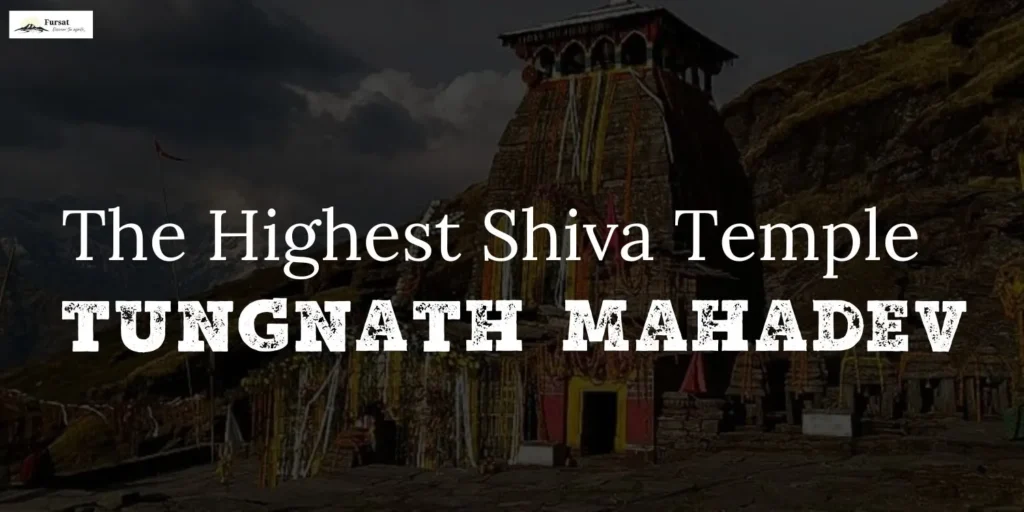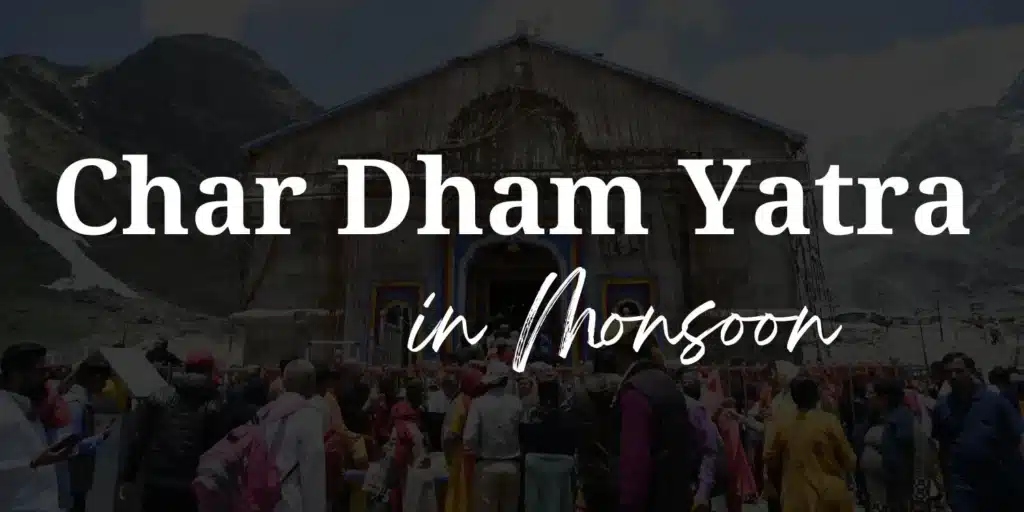Mahasu, the devta of justice, is associated with the native Jaunsar Bawar region in the Dehradun district of Uttarakhand. The primary temple devoted to Mahasu is located in Hanol.
This temple, built in the 9th century, showcases an intriguing fusion of architectural styles.
According to legend, even the Pandavas, along with their mother, Kunti, are said to have visited this very place.
So, let’s take a trip to Hanol.
About the Temple
Uttarakhand is home to many captivating local tales related to its local deities. One of the most intriguing stories is about the local deity Mahasu, revered as the deity of justice. Mahasu is closely associated with the indigenous region of Jaunsar Bawar in the Dehradun district.
The primary temple dedicated to Mahasu is located in the village of Hanol, near the eastern bank of the Tons River, along the Tiuni-Mori motor road.
The name ‘Hanol’ has its origins in a Brahmin named Huna Bhat, previously known as Chakrapur. Before that, this place was known as Chakrapur.
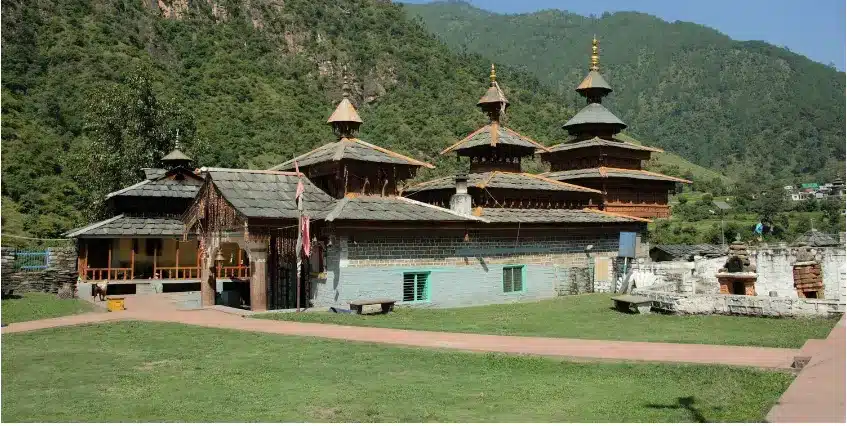
In the Dvapara Yuga, the Pandavas, having escaped the lacquer house, sought refuge at this very place. The temple, is located at an elevation of 1,250 meters above sea level, is a wonderful example of architectural fusion from the 9th century.
However, records from the Archaeological Survey of India (ASI) suggest that the temple’s construction may date back to the 11th and 12th centuries. The ASI is responsible for its preservation today.
During excavations, the ASI found many old statues and idols of different gods, like Shiva-Shakti, Shiva Linga, Durga, Vishnu-Lakshmi, Surya, and Kubera. These valuable objects are now in the Hanol Museum for everyone to see.
The Divine Family of Lord Mahasu
In reality, Mahasu is not a single deity; it is a collective name for four deities. In the local language, the word “Mahasu” is derived from “Mahashiva.”
These four Mahasu brothers are Basik Mahasu, Pubasik Mahasu, Buthia Mahasu (Bautha Mahasu), and Chalda Mahasu, all considered embodiments of Lord Shiva. Among them, Basik Mahasu holds the highest stature, while Bautha Mahasu, Pubasik Mahasu, and Chalda Mahasu follow in second, third, and fourth place, respectively.
Bautha Mahasu’s temple can be found in Hanol, Basik Mahasu’s in Maindraith, Pubasik Mahasu’s in the Bangaan area, including Thadiyar and Devati-Devvan.
In contrast, Chalda Mahasu is always on a journey across Jaunsar-Bawar, Bangaan, Fatah-Parvat, and Himachal regions.

Local residents regularly transfer the palanquin of these deities from one place to another for worship and rituals. The deity’s presence during these journeys allows devotees to have a chance to witness Chalda Mahasu after several decades.
In some areas, generations pass without the opportunity to see the deity.
In Uttarakhand, from Uttarkashi to the entire Jaunsar-Bawar region and the Rampuragana of Ranwayi, as well as in Himachal Pradesh’s Sirmaur, Solan, Shimla, Bishaihar, and Jubbal, Mahasu is revered as the Isht Dev (family deity). In these regions, Mahasu is not only seen as the deity of justice but also the temple is viewed as a court of justice.
Also Read: 7 Temples In Kumaon You Must Visit
The Main Temple of the Four Mahasu Brothers
In Hanol, the primary temple is dedicated to the four Mahasu brothers. The temple primarily worships Bautha Mahasu. At a place called Maindraith, Basik Mahasu is worshipped.
In the Bangaan area, located on the right bank of the Tons River, Pubasik Mahasu is venerated in the village of Thadiyar, Uttarkashi. Thadiyar is situated around three kilometers away from Hanol.

The youngest of the four brothers, Chalda Mahasu, is a deity who loves to wander. He spends twelve years each in Uttarkashi and Dehradun districts.
Every year, his worship takes place in different locations, including Haja, Bishoi, Koti Kanasar, Mashk, Udpalta, Mauna, and other prominent worship sites.
Also Read: Tungnath Mahadev- The Highest Shiva Temple
Guardians of Mahasu Temples
In the Hanol Temple devoted to Bautha Mahasu, the people from Ninus, Puttar, and Chatara villages serve as caretakers and priests. Similarly, in the Maindraith Temple where Basik Mahasu is worshipped, those responsible for the rituals come from Ninus, Bagi, and Maindraith villages.
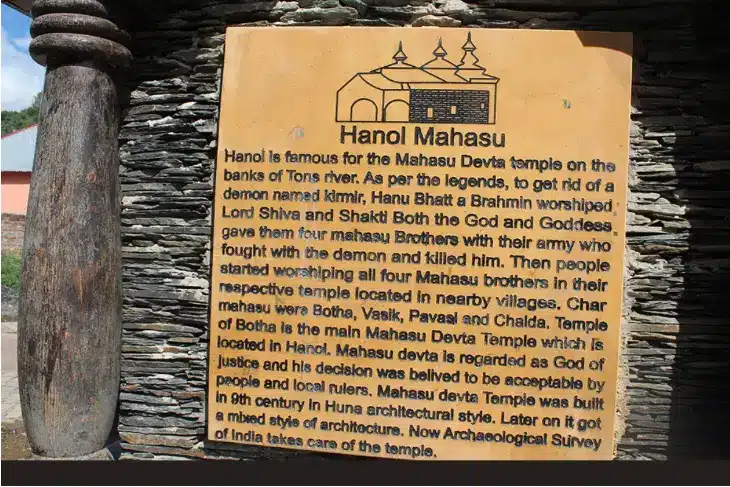
In both temples, each village takes turns overseeing the rituals for a month. The Temple of Pubasik Mahasu in Thadiyar is maintained by priests exclusively from the Daglu village. However, for the wandering Chalda Mahasu, custodians from Ninus, Puttar, Chatara, and Maindraith villages participate in the worship procession, carrying the deity on a palanquin.
Also Read: Neem Karoli Baba Ashram Nainital
The Four Heroic Deities of Mahasu
Each of the four Mahasu deities has a corresponding heroic figure. They include Kafala Veer (associated with Basik Mahasu), Gudaru Veer (linked to Pubasik Mahasu), Kailu Veer (connected to Bautha Mahasu), and Sekudia Veer (related to Chalda Mahasu).
In Jaunsar-Bawar, there are four small mythical temples dedicated to each of these valiant deities.
The Architecture of Mahasu Temple
The main temple’s sanctum has a Nagara-style dome. The construction of the temple began with the mandapa and the main mandapa added later. The architectural style of this temple distinguishes it from other temples in Uttarakhand, characterized by its ornate wooden and metal-decorated domes.
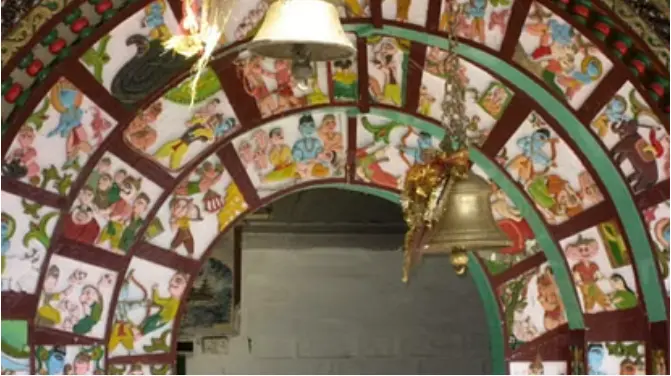
The Mahasu Temple has four doors, from the entrance gate to the sanctum. At the entrance gate, there’s a representation of the Navagrahas, the nine celestial bodies, which includes the Sun, Moon, Jupiter, Mercury, Venus, Saturn, Mars, Ketu, and Rahu. The first and second doors are adorned with artwork representing various deities in the form of garlands.
At the second door, the temple’s musicians support the rituals with traditional instruments like drums and trumpets. At the third door, local people, devotees, and pilgrims pay their respects. The final door, leading to the sanctum, is only accessible by the priest during worship ceremonies.
Also Read: The Legend Of Osla Village
The Legendary Tale of Hanol Temple’s Construction
According to local belief, the Pandavas, with the assistance of the divine sculptor Vishwakarma, constructed the Hanol Temple by moving massive stones from the Ghata Mountain (part of the Shivalik mountain range). The temple, known for its remarkable architecture, features 32 intricately carved stone corners and domes, from the foundation to the pinnacle.
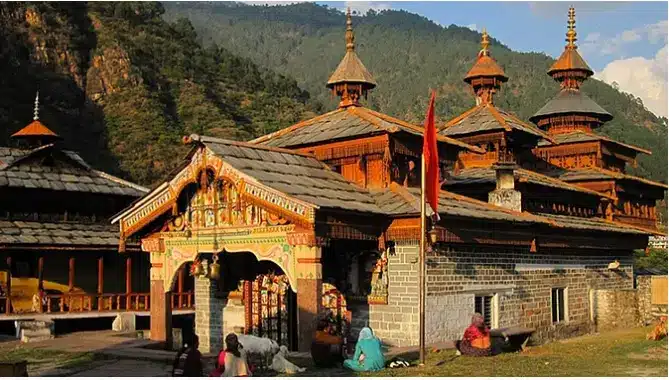
Inside the temple’s sanctum, a colossal stone brought from the Ghata Mountain crowns the shrine, dedicated to Bhimsen. The extraordinary craftsmanship adds to the grandeur of the temple, leaving an indelible mark on visitors.
The Connection With President House
Inside the temple’s sanctum, only the temple priest is allowed; devotees are prohibited from entering. A mysterious water source flows within the sanctum, and its origin and outlet remain a mystery. This water is offered to devotees as a sacred blessing.
Additionally, a divine flame always burns in the sanctum. Notably, Mahasu Devta has a direct connection with the Presidential Residence. Every year, the Presidential Residence sends salt as an offering to this temple.
How to Reach?
To reach the Mahasu Devta temple from Dehradun, there are three road routes available. The first route spans 188 kilometers, passing through Dehradun, Vikasnagar, Chakrata, and Tyuni before reaching Hanol.
The second route covers 175 kilometers, passing through Dehradun, Mussoorie, Nainbagh, Purola, and Mori on the way to Hanol.
The third route, at 178 kilometers, takes you from Dehradun through Vikasnagar, Chibarau Dam, Kwaanu, Minas, Hataal, and Tyuni before reaching Hanol.
Also Read: Healthy Benefits Of Buransh Juice

